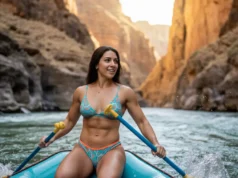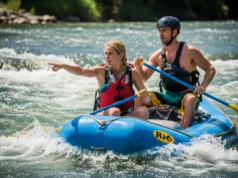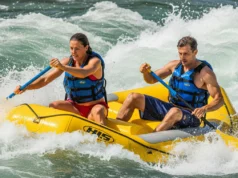In this article
The roar of an unseen rapid fills the canyon ahead. To the untrained eye, it’s a terrifying wall of chaos. To the trained eye, it’s a story—a clear narrative of deep water channels, hidden rocks, and safe passage. That story is written in the language of moving water, and this guide will teach you how to read a river. We will move beyond a simple glossary of whitewater river features and provide a complete Hazard Identification System, transforming your perception of the river from a series of random obstacles into a predictable and navigable path. True outdoor competence in whitewater rafting and kayaking safety comes from turning theoretical knowledge into a practical, systematic framework for making real-time decisions. This kind of river reading isn’t about memorizing terms; it’s about learning a language to anticipate water flow and mitigate risk.
By the end of this guide, you will no longer be a passive observer of chaotic whitewater. You will be an empowered rafter, equipped with a cognitive river reading system to interpret the river’s story, identify the safest path, and command your craft with confidence. We will understand the “why” behind the river’s power, learn the “what” of its visual dictionary, master the “how” of raft-specific navigation, and finally, build a system to put it all together.
Why Does a River Behave the Way It Does? Understanding the Engine of Flow
Before you can read the river’s story, you have to understand the forces that write it. This isn’t just abstract science; this is the hydrology 101 that powers every wave, every hole, and every eddy. Understanding these river dynamics allows you to predict the river’s behavior rather than just react to it.
What Are the Three Forces That Create and Shape a Rapid?
Every rapid you will ever encounter, from a gentle riffle on a small creek to a thundering Class V torrent, is born from three fundamental forces working in concert: Gradient, Volume, and Constriction. This is the trifecta of whitewater.
Gradient is the steepness of the streambed, measured in feet per mile. Think of it as the river’s throttle. A steeper gradient means a steeper slope, which gives the water a higher potential velocity and increases the current speed.
Volume, or water discharge, is the amount of water moving through the stream channel. We measure this in Cubic Feet per Second (CFS), and it’s the fuel powering the river’s engine. One CFS is about the size of a basketball of water flowing past a single point in one second. A river running at 3,000 CFS has three thousand of those basketballs passing by every single second. For an authoritative look at terms like discharge, the U.S. Army Corps of Engineers fact sheet is an excellent resource for river-running info.
Constriction is any narrowing of the river channel. It acts like a nozzle on a firehose, forcing the same volume of water through a much smaller space. This dramatically increases the water velocity and energy, creating the powerful whitewater features we see on the water surface.
Understanding how these three forces interplay is the first and most critical step to predictive river reading. When a high-volume river enters a steep, constricted canyon, you know the engine is running at full throttle.
This interplay is what disrupts a river’s natural state of smooth, predictable laminar flow. The trifecta forces create the chaotic, aerated “turbulent” flow that defines whitewater. In river bends, this becomes even more complex. Centrifugal force pushes the fastest, most powerful current to the outside of the turn. This creates a corkscrew-like helical flow that scours the outer bank, making it deeper, while depositing sediment on the inside bend, making it shallower. This knowledge is immediately actionable: the safest and deepest channel is almost always on the outside of a bend. However, that same erosive force is what creates dangerous river hazards like undercut rocks and strainers.
With the engine of the river understood, let’s learn how to read its dashboard—the river gauges that tell us exactly how much power it’s running with today.
What Are the Key Signals the River is Sending? A Visual Glossary for Rafters
The river communicates through a distinct visual language. Learning this language allows you to distinguish safe paths from life-threatening hazards. This section is your dictionary for all the key river features.
Which Features Signal a Safe and Deep Channel?
These are the “green lights” of the river environment, the signs that guide you toward the safest and most efficient route.
The most important green light on the river is the Downstream V. The tongue, or “downstream v,” generally represents the target path forward through whitewater. It’s a smooth, V-shaped chute of water pointing downstream, indicating the main current flowing between two obstacles. This is your primary target, as it points to the deep water channel, the path that is generally safest and least obstructed. Following the tongue often leads you into a Wave Train or Standing Waves. These are a series of stationary river waves, also called haystacks, formed as a fast current passes over submerged objects or slows down. A wave train generally indicates a channel that is deep and free of major, boat-stopping obstructions.
Another critical feature is an Eddy. These are calm resting areas, or smooth water havens, with calm or even upstream-flowing water found downstream of an obstruction like a boulder or a point of land. Eddies are your safe zones—places to stop, scout, regroup, or set up a rescue. The turbulent boundary separating the downstream current from the calm eddy water is called the Eddy Line. Understanding eddy mechanics is key; crossing this line effectively requires momentum and a confident best approach angle. Mastering the skill to eddy hop is fundamental to river-running, and we’ve got a whole guide dedicated to mastering the technique to catch an eddy.
Finally, a Pillow or Cushion Wave is a buildup of water on the upstream face of a large, visible obstacle like a boulder. This “cushion” of water isn’t a hazard; it’s a tool. A skilled guide can use this cushion to deflect the raft away from a direct impact, using the river’s own force as a buffer.
When you see a sequence of a clear Downstream V followed by a uniform wave train and a large, calm eddy on the side, that is the river’s way of telling you, “This is the safe path.” This pattern recognition is the heart of reading rivers. For more definitions, the USGS glossary of water basics provides excellent scientific context.
What Are the Most Dangerous Hazards and How Do You Avoid Them?
Now that you can spot the “green lights,” it’s time to learn the non-negotiable “red lights”—the dangerous river hazards that demand immediate avoidance.
The Upstream V is the definitive signal of a submerged hazard. It is a V-shaped, often foamy water disturbance pointing upstream, formed as water passes over a submerged rock or log. The rule of thumb is absolute: avoid the point of the V. That point reveals a submerged obstruction.
Holes, or hydraulics, are depressions formed when water pours over an obstacle and circulates back on itself. These dangerous hydraulics can be classified as Stoppers, which may slow a boat, or Keepers (a type of reversal), which can be identified by their uniform, smiling shape and powerful backwash. A keeper hole can trap a boat or swimmer indefinitely and are common at low-head dams and weirs.
A Horizon Line is a distinct, flat line across the river where the water’s surface simply disappears. This is the universal sign for a major vertical drop like a waterfall, a large ledge, or a dam. The only safe action is to immediately get to shore and scout.
Arguably the most lethal hazards on the river are Strainers and Sweepers. Strainers are obstructions like fallen trees or logs floating in the stream channel that let water pass through but will trap objects like boats and people, posing a severe entrapment hazard. Accident data from organizations like NCBI/PubMed reveals that strainers are a leading cause of fatalities, paradoxically on “easy” Class I-II water where novices are less vigilant. This is a critical point: the deadliest hazards are often on the “easiest” water. Other severe hazards include Undercut Rocks, where the current flows under the rock into a submerged cavern, and Sieves, which are jumbles of rocks that strain the water. A critical piece of your safety gear for dealing with an entrapment hazard is a good river knife; we discuss the critical role of a reliable river knife in our gear guides.
Pro-Tip: Strainers are magnets for gear and boats, especially on the outside of river bends where the current is strongest. When you see a freshly fallen tree, always assume its submerged branches extend much further into the river than you can see. Give the entire area a wider berth than you think you need.
Lastly, Foot Entrapment is the cardinal sin of whitewater swimming, and a major cause of drowning. Never, ever attempt to stand up in moving water that is deeper than your knees. If your foot gets wedged between rocks, the force of the current will push your body over and your face underwater. Always assume the “safe swimmer” position: on your back, feet up and pointed downstream.
How Do You Apply This Knowledge to Steer a Raft? From Reading to Reacting
To read and respond to visual clues is half the battle; the other half is translating that knowledge into decisive action. This section translates hydrological theory into practical, raft-specific maneuvers, focusing on how a larger craft and a coordinated team execute a navigation strategy on the water.
What Are the Essential Raft-Specific Maneuvers?
Rafts, unlike a whitewater kayak, have significant momentum and are powered by a team. Our maneuvers reflect this.
The Ferrying technique is the skill of using the river’s current to move laterally across the flow. By setting the raft at an angle (around 45 degrees) to the current and paddling, you can cross the river with minimal downstream travel to line up for the next move. This is a fundamental skill for precise positioning.
Punching Holes is a core rafting technique. Rafts often rely on momentum to drive through the weaker part of a wave or hydraulic, preventing a stall. This requires the entire crew to paddle hard and in unison to build the necessary speed.
Eddy Turns & Peel Outs are about control. Entering an eddy requires punching across the eddy line with decisive momentum and angle. Exiting, or “peeling out,” requires pointing the raft upstream and paddling assertively back into the main current to get underway smoothly.
Pro-Tip: The most common mistake when peeling out is not having enough of an upstream angle. If you enter the current too sideways, the river will grab your downstream tube and spin you out of control. Point that nose upstream, paddle hard, and let the current swing your stern around.
The single most critical team maneuver to prevent a flip is the High-Side. When a raft is pushed sideways against an obstacle or into a powerful hole, the crew must immediately shift their weight to the downstream tube (the “high side”). This action, a form of bracing for stability, prevents the upstream tube from being caught by the current, being pulled underwater, and flipping the boat. It’s a counter-intuitive but life-saving reflex that must be practiced. We go into extreme detail on practicing this life-saving high-side command in our advanced skills guide.
All of these maneuvers, detailed in academic resources like those from Frostburg State University, are useless without a coordinated crew. Effective river reading by the guide must be translated into clear, concise paddle commands that the team can execute instantly and in unison.
How Do You Synthesize Everything into a Reliable Safety System?
With a vocabulary of features and a set of physical maneuvers, the final step is to integrate them into a systematic process. This capstone section provides a structured, repeatable framework that integrates all prior knowledge—from physics to features to maneuvers—into a cohesive decision-making process for any situation.
How Can You Systematically Analyze a Rapid Before You Enter It?
To ensure no critical element is overlooked when scouting, many river runners use the W.O.R.M.S. Method. It’s a simple mnemonic that provides a structured checklist for your trip planning and on-water decisions.
- W – Water: Where is the main current going? Identify the primary Downstream V’s and current lines.
- O – Obstacles: What hazards are present? Identify Upstream V’s, keeper holes, and strainers.
- R – Route: Based on the water and obstacles, what is your intended line? Establish a Plan A, B, and C.
- M – Markers: What distinct landmarks (a specific rock, tree, or wave) will you use to time your maneuvers once you are on the water and your perspective has changed?
- S – Safety: Where are the downstream eddies for recovery? What are the safety protocols if there’s a swimmer? Is downstream safety set with throw ropes and other safety gear? This ties directly into assembling a trip-specific river rescue kit.
Creator’s Note: A simple, clean infographic detailing the W.O.R.M.S. method would be highly effective for retention. Each letter could have a corresponding icon and a one-sentence summary, making it a scannable and memorable tool.
The W.O.R.M.S. method moves you from simply identifying features to actively building a navigational plan that includes contingencies and safety protocols. But true mastery begins before you even arrive at the river by reading the larger environmental context, using resources like the National Weather Service hydrology education page to understand the broader forecast and potential for floods.
Conclusion
Reading a river is a learnable skill. It’s built on understanding the physics of gradient, volume, and constriction. The river speaks in clear visual signals: Downstream V’s show the safe path, while Upstream V’s, keeper holes, and horizon lines signal danger. We know from hard data that strainers are a top cause of fatalities, especially on seemingly easy water where vigilance is low. By using a systematic framework like W.O.R.M.S., you can transform reactive paddling into proactive, safe navigation by forcing a complete analysis of Water, Obstacles, Route, Markers, and Safety.
Continue building your wilderness instinct by exploring our complete library of rafting safety and skills guides. Share the one river feature that first “clicked” for you in the comments below.
Frequently Asked Questions
What does a downstream V mean in a river?
A downstream V, also called a “tongue,” is a V-shape of smooth water pointing downstream that indicates the deepest, fastest, and safest channel. It is formed as water accelerates between two obstacles and is the primary “green light” rafters look for when choosing a line.
What are the most dangerous river hazards for rafters?
The most dangerous hazards are strainers (e.g., fallen trees), keeper holes (retentive hydraulics), low-head dams, and undercut rocks. According to accident data, strainers are particularly lethal because they can appear on “easy” rivers where people are less prepared for an entrapment hazard.
What is the difference between an upstream V and a downstream V?
The key difference is the direction the “V” points: a downstream V points with the current and signals a safe channel, while an upstream V points against the current and signals a submerged obstacle. The rule is to aim for the center of a downstream V and actively avoid the point of an upstream V.
How do water levels (CFS) change a rapid?
The water level impact on a rapid is dramatic: low water makes it more technical and “bony” with exposed rocks, while high water can wash out features or create massive, powerful hydraulics. The seasonal variability is huge. It is crucial to check the river’s CFS (Cubic Feet per Second) on a river gauge before a trip, as a familiar river reach can become unrecognizable and much more dangerous at a different flow.
Risk Disclaimer: Whitewater rafting, kayaking, and all related river sports are inherently dangerous activities that can result in serious injury, drowning, or death. The information provided on Rafting Escapes is for educational and informational purposes only. While we strive for accuracy, the information, techniques, and safety advice presented on this website are not a substitute for professional guide services, hands-on swiftwater rescue training, or your own critical judgment. River conditions, including water levels, currents, and hazards like strainers or undercut rocks, change constantly and can differ dramatically from what is described on this site. Never attempt to navigate a river beyond your certified skill level and always wear appropriate safety gear, including a personal flotation device (PFD) and helmet. We strongly advise rafting with a licensed professional guide. By using this website, you agree that you are solely responsible for your own safety. Any reliance you place on our content is strictly at your own risk, and you assume all liability for your actions and decisions on the water. Rafting Escapes and its authors will not be held liable for any injury, damage, or loss sustained in connection with the use of the information herein.
Affiliate Disclosure: We are a participant in the Amazon Services LLC Associates Program, an affiliate advertising program designed to provide a means for us to earn advertising fees by advertising and linking to Amazon.com. As an Amazon Associate, we earn from qualifying purchases. We also participate in other affiliate programs and may receive a commission on products purchased through our links, at no extra cost to you. Additional terms are found in the terms of service.





